Marketing technology (Martech) has transformed from a simple efficiency tool into the fundamental backbone of marketing operations and revenue functions. This shift is accelerated by increasingly complex customer journeys, omni-channel engagements, multiplying data sources, and growing demands for personalized experiences at scale. In this blog post, we will examine the architecture of modern martech stacks and provide ideas for maximizing their return on investment.
A well-structured martech stack functions across three interconnected layers, each fulfilling a specific role in the customer lifecycle journey.
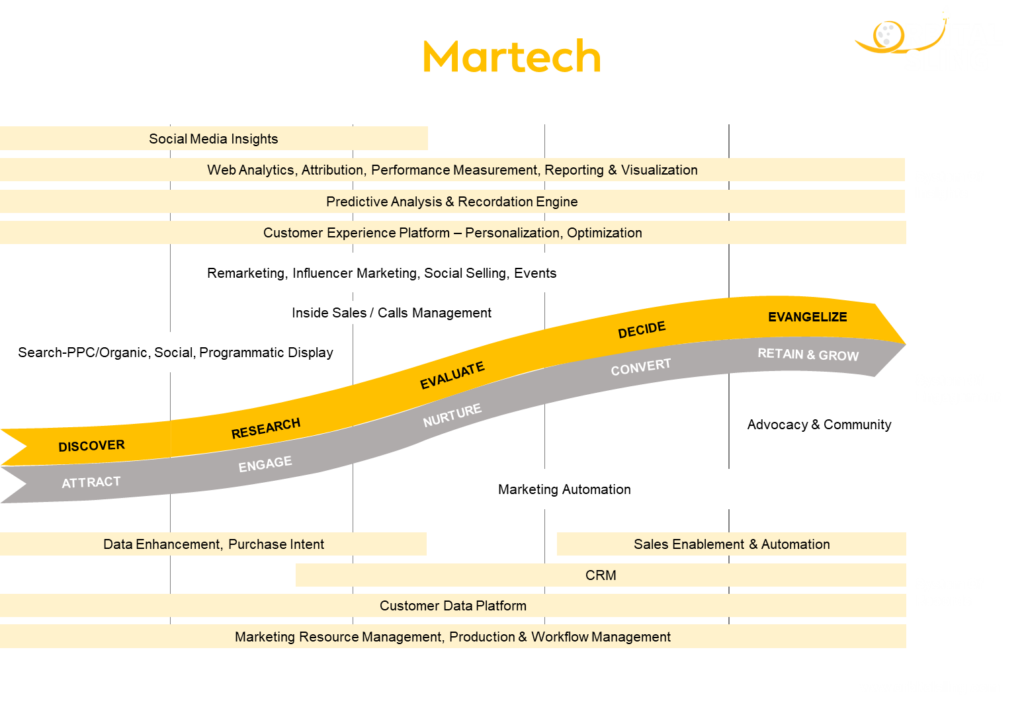
System of records – The foundation layer
At the base of any effective martech stack lies the system of records, the technological bedrock that houses your customer data. These systems are designed for data persistence, integrity, and accessibility.
Core components include:
- Customer Data Platforms (CDPs): Unified repositories that collect, organize, and activate customer data across touchpoints
- Customer Relationship Management (CRM) systems: Tools that manage customer interactions, relationships, and historical engagement data
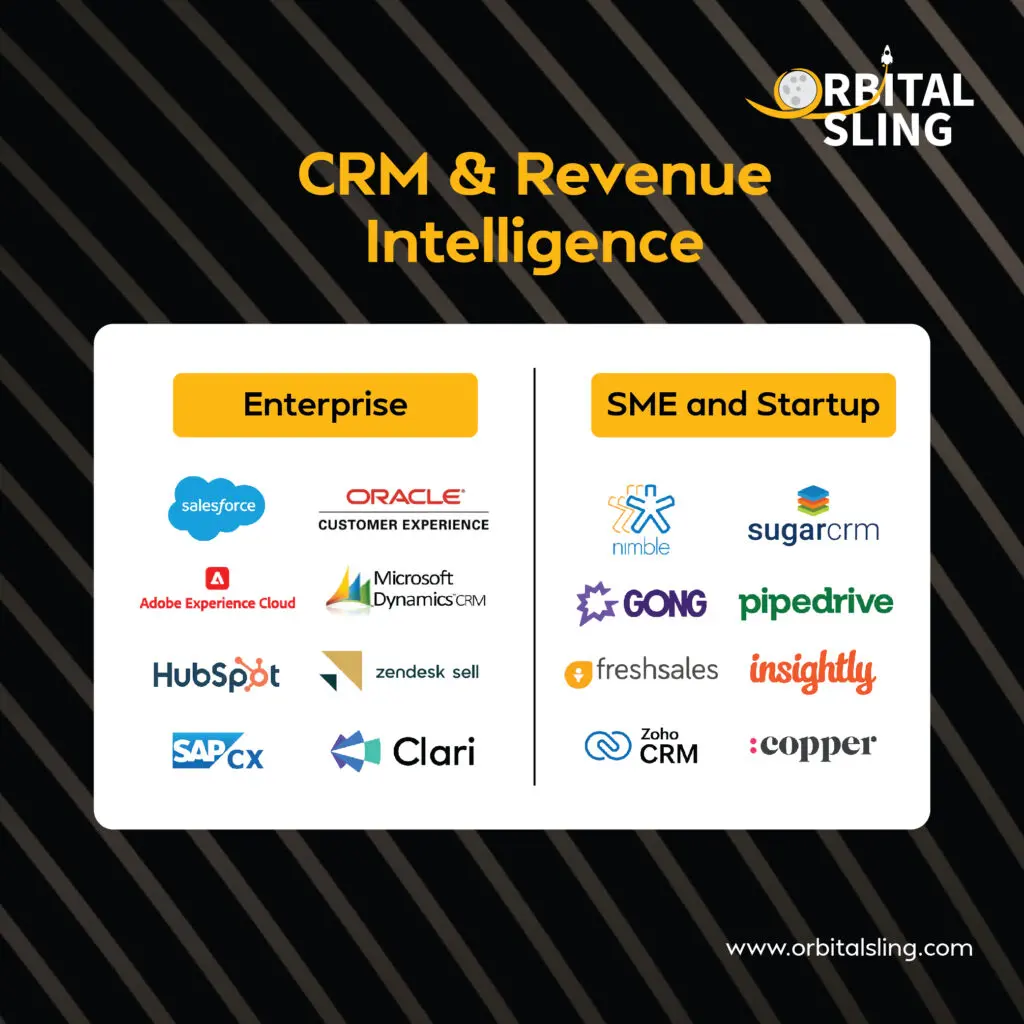
- Marketing Resource Management (MRM): Systems that govern production workflows, asset management, and marketing operations
- Data Enhancement and Purchase Intent: Tools that enrich first-party data with additional intelligence
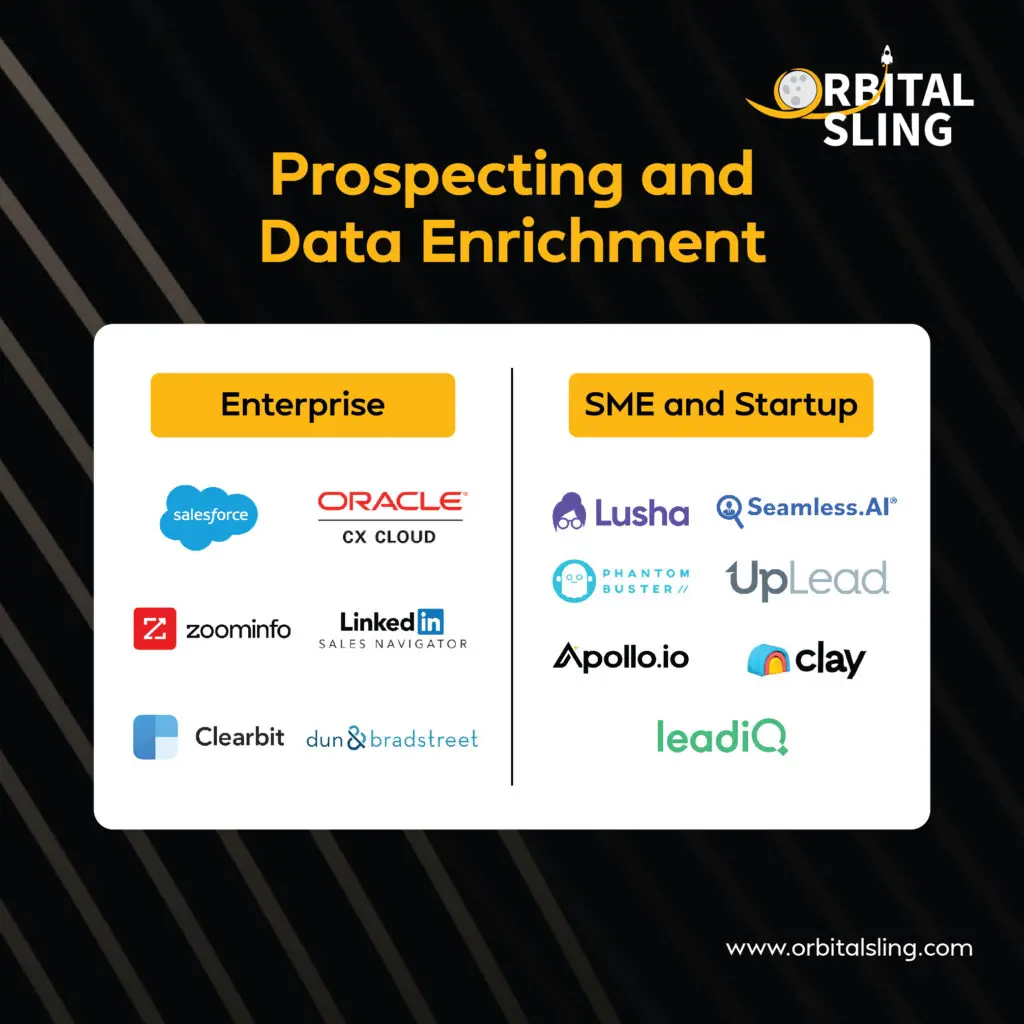
For enterprises, solutions like Salesforce Data Cloud, Oracle CX, and Microsoft Dynamics dominate this space, providing robust integration capabilities and comprehensive data governance. Startups typically leverage more agile platforms like SugarCRM, Pipedrive, or Zoho CRM that offer lower barriers to entry while maintaining core functionality. The technical architecture of these systems prioritizes data normalization, schema flexibility, and API accessibility—creating a source of truth for downstream systems.
System of engagement – The orchestration layer
The middle layer consists of engagement technologies that operationalize the data stored in your system of records. This layer executes campaigns, manages customer touchpoints, and facilitates interactions across channels.
Critical components include:
- Marketing Automation Platforms: Systems that trigger personalized communications based on customer behaviors and predefined workflows
- Email Verification & Outreach Tools: Platforms ensuring deliverability and campaign execution

- Account-Based Marketing (ABM) Solutions: Tools focusing on targeted account engagement strategies.
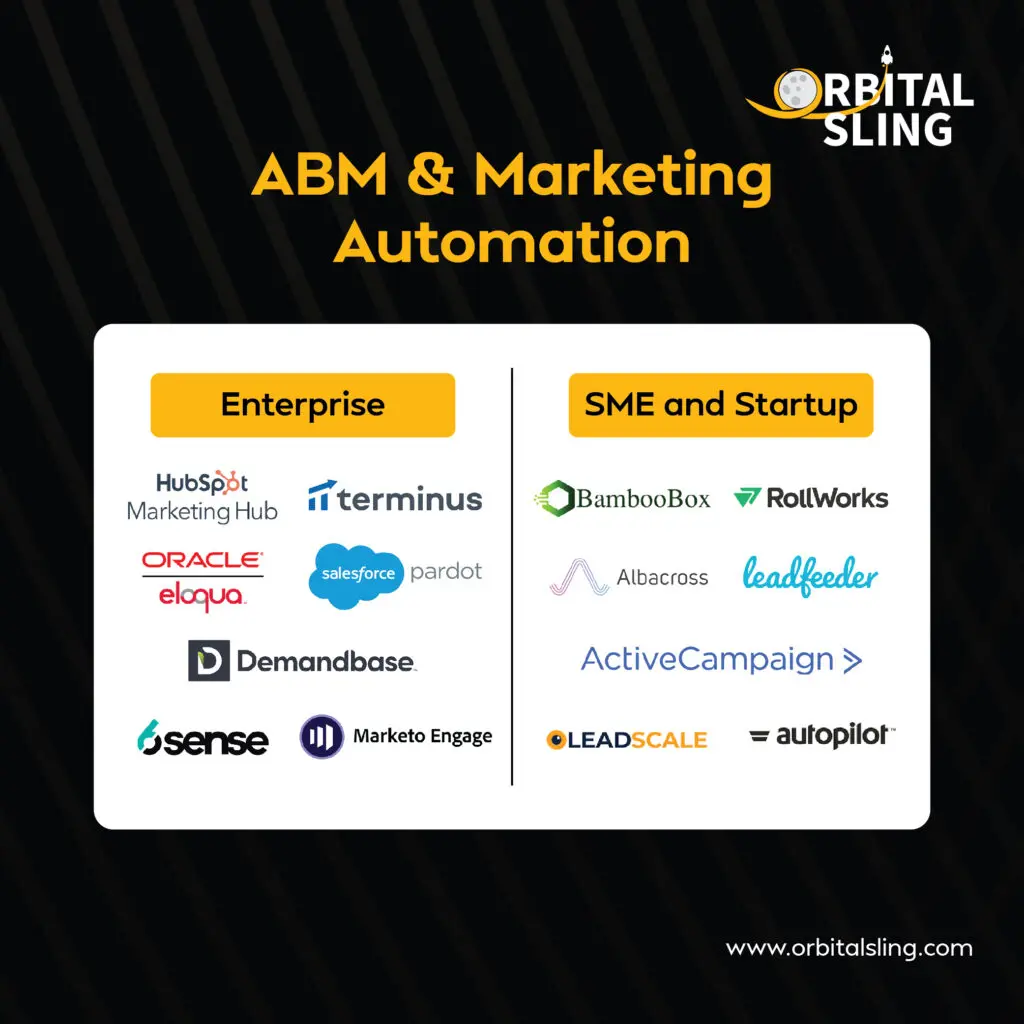
- Sales Automation Systems: Technologies that streamline prospecting, outreach, and follow-up processes.
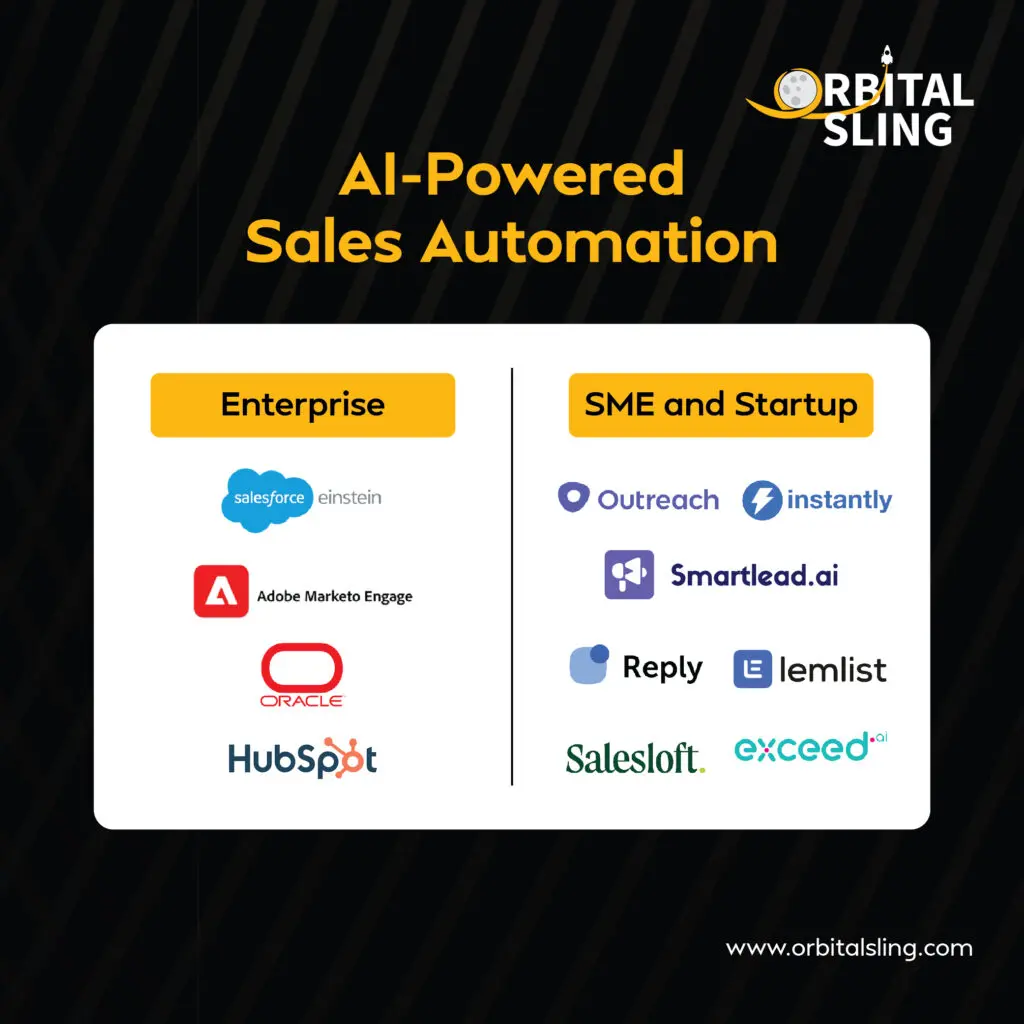
- Content Management Systems (CMS): Platforms that host and deliver digital content experiences.

Enterprise-grade solutions in this layer include Adobe Experience Manager, HubSpot Marketing Hub, and Salesforce Pardot—platforms designed for multi-market deployment with complex governance requirements. Meanwhile, startups often leverage tools like ActiveCampaign, MailChimp, and Webflow, which provide faster time-to-value with simplified configuration options. From a technical perspective, the engagement layer must balance real-time performance with comprehensive orchestration capabilities, employing event-driven architectures that can process customer interactions as they occur.
System of insights: The intelligence layer
The top layer houses analytics and measurement technologies that transform data into actionable insights, feeding strategic decisions and optimizing engagement tactics.
Key components include:
- Web Analytics & Attribution: Platforms measuring digital behavior and conversion pathways

- Social Media Insights Tools: Solutions for monitoring engagement and conversation on social channels
- Predictive Analysis & Recordation Engines: Systems using machine learning to forecast outcomes and recommend actions
- Customer Experience Platforms: Technologies measuring satisfaction, loyalty, and experience quality

Enterprises typically deploy sophisticated solutions like Tableau, Google Analytics 360, and Adobe Analytics, which provide multi-dimensional analysis capabilities and handle massive data volumes. Startups often turn to KISSmetrics, Amplitude, or Matomo, which offer more focused analytics capabilities with lower implementation barriers.
The technical architecture of this layer increasingly leverages machine learning pipelines, real-time data processing frameworks, and visualization libraries that transform complex datasets into comprehensible insights.
The myth of the “perfect” initial implementation
Many organizations approach martech as a one-time investment, seeking to build the “perfect” stack from the outset. This approach fundamentally misunderstands the evolving nature of both marketing requirements and technological capabilities. The most critical insight for modern marketers is understanding that martech is not a static implementation but a dynamic ecosystem that evolves with your business.
API landscapes evolve, data schemas change, and integration patterns mature. A stack designed for current needs will inevitably face compatibility challenges as your requirements grow in sophistication.
Successful organizations adopt an iterative approach, treating their martech stack as a product that requires continuous refinement and optimization. This product mindset necessitates dedicated ownership and, effectively, a product manager for each major segment of your stack.
The non-linearity of martech evolution
Contrary to conventional wisdom, martech evolution isn’t a linear progression from basic to advanced tools. Organizations can strategically leapfrog certain technological stages if they have clarity on their data strategy and future requirements.
For example, implementing a sophisticated Customer Data Platform (CDP) early can potentially eliminate the need for multiple point solutions in your engagement layer. A CDP with robust activation capabilities can directly execute personalized communications, effectively bypassing the need for separate email, social, and advertising platforms.
A CDP with real-time segmentation capabilities and direct integrations to execution channels can use streaming data architectures (like Kafka or Kinesis) to trigger personalized experiences without the latency introduced by multiple system handoffs.
The technical challenges of martech integration
While the conceptual architecture of martech stacks is relatively straightforward, the technical implementation presents significant challenges.
Data Governance and Integration Complexity
Modern martech stacks manage petabytes of customer data across dozens of systems, creating complex data governance requirements.
- Identity Resolution: Implementing deterministic and probabilistic matching algorithms to create unified customer profiles across systems
- Data Synchronization: Establishing bi-directional sync patterns that maintain data consistency while respecting system-specific data models
- Consent Management: Building technical infrastructure to propagate privacy preferences across all systems in compliance with regulations like GDPR and CCPA
Real-time activation requirements
Customer expectations have shifted toward real-time personalization, requiring martech architectures that can process and activate data with minimal latency.
- Event-Streaming Architectures: Implementing Kafka or similar technologies to process customer interactions as they occur
- Edge Computing Capabilities: Deploying decisioning logic closer to customer touchpoints to reduce response times
- Webhook Infrastructures: Creating standardized notification systems that trigger actions across platform boundaries
Measurement and attribution complexity
As customer journeys become increasingly non-linear, spanning multiple channels and devices, traditional attribution models break down.
- Multi-Touch Attribution Models: Implementing probabilistic algorithms that distribute conversion credit across touchpoints
- Marketing Mix Modeling: Developing statistical models that quantify the impact of marketing initiatives on business outcomes
- Incrementality Testing Frameworks: Building experimentation infrastructures that isolate the causal impact of marketing activities
Optimizing your martech stack
Given these challenges, how should organizations approach martech stack optimization? Here’s a technical roadmap you can consider.
Begin by mapping your existing martech architecture, focusing on:
- Data Flow Patterns: How information moves between systems, identifying bottlenecks and redundancies
- Integration Methods: Cataloging APIs, webhooks, batch processes, and manual transfers
- Technical Debt: Assessing custom integrations, deprecated connections, and non-standard implementations
Before adding or replacing tools, establish a coherent data layer that can serve as your martech foundation:
- Customer Data Platform Selection: Evaluate CDPs based on their data modeling flexibility, identity resolution capabilities, and activation features
- Data Standardization: Implement consistent taxonomies, naming conventions, and event schemas across platforms
- API Management: Deploy an API gateway to standardize integration patterns and monitor cross-system communication
Focus on reducing latency in your marketing operations by:
- Event Stream Processing: Implementing real-time data pipelines that trigger immediate actions based on customer behaviors
- Decisioning Engines: Deploying rules engines or machine learning models that can make personalization decisions in milliseconds
- Caching Strategies: Optimizing content delivery through strategic caching of personalization assets
Design your stack with analytics as a core consideration, not an afterthought:
- Tracking Implementation: Deploying consistent tracking across all customer touchpoints
- Experimentation Framework: Building A/B and multivariate testing capabilities into your engagement platforms
- Data Warehousing Strategy: Implementing a central repository for cross-platform analysis
Governance and ownership
Perhaps the most overlooked aspect of martech is the organizational structure required to support it. The traditional division between marketing (who uses the tools) and IT (who implements them) creates friction that impedes optimization. A more effective approach involves:
- Marketing Technology Teams: Dedicated groups with both marketing domain knowledge and technical expertise
- Center of Excellence Models: Centralized teams that establish standards while supporting decentralized execution
- Joint Ownership Structures: Shared accountability between marketing, IT, and data teams
This approach addresses a fundamental challenge – while CIOs may understand technology architecture, they often lack marketing context. Conversely, CMOs understand marketing requirements but may not appreciate technical complexity. A successful structure might establish a Marketing Technology Council with representation from Marketing (primary tool users), IT (integration owners), Data Science (analytics and ML owners), and Information Security (compliance owners). This council reviews new technology acquisitions, establishes integration standards, and oversees the technical roadmap.
From implementation to continuous evolution
The shift from viewing martech as a one-time implementation to treating it as a continuously evolving ecosystem marks a fundamental change in how organizations approach marketing technology. This evolution demands both technological sophistication and organizational maturity. The most successful organizations approach martech with:
- A product mindset that treats the stack as a living system requiring ongoing optimization
- Technical excellence in data architecture, integration patterns, and real-time capabilities
- Organizational alignment between marketing, technology, and data teams
Organizations that adopt this approach create martech stacks that meet current requirements and adapt to address future challenges, transforming marketing technology from a cost center into a genuine competitive advantage.
OrbitalSling partners with organizations to optimize martech stacks. We provide tech-agnostic advice spanning open-source options to enterprise-grade applications, helping customers select appropriate technology for their specific context and operationalize these tools with exceptional data integrity for improved ROI.

